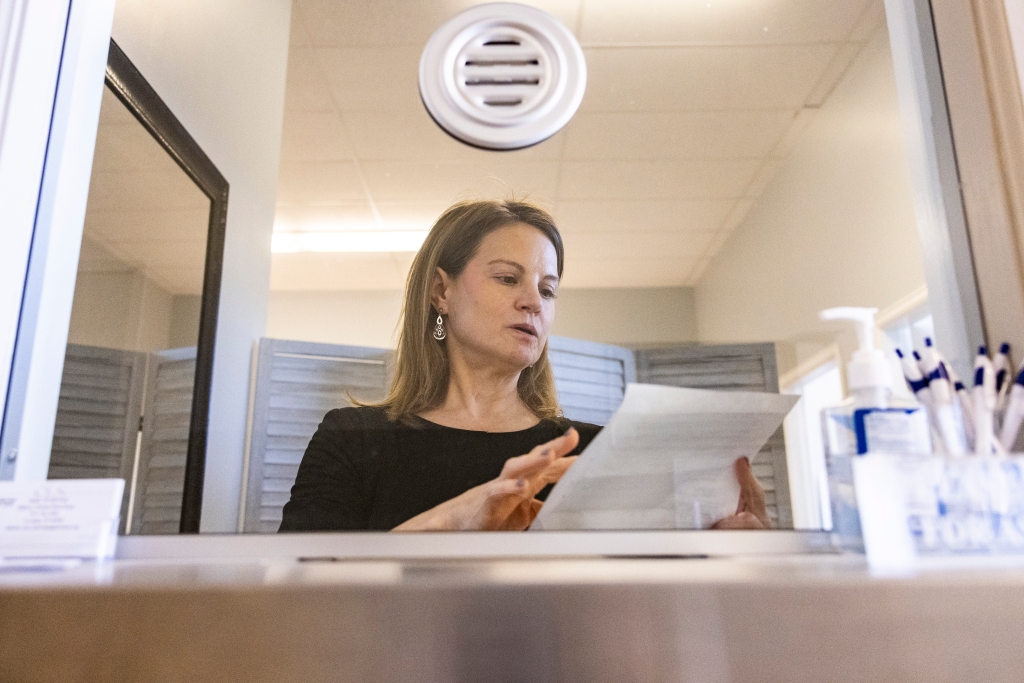
Rural Colorado’s shortage of attorneys, lawyers hit ‘a crisis point’
[ad_1]
Attorney Kim Verhoeff has taken to recruiting her neighbors to the legal profession.
Buried in work and worried about her town’s future, she’s pitched career changes to friends and acquaintances, a teacher, a social worker — you can make a good living as an attorney, there’s lots of work to be done, I’ll help you get established. It’s become a practiced spiel, occasionally taking the tone of a used car salesman.
“Do you want to be an attorney?” she asked a reporter during a recent phone call.
When Verhoeff started her career 30 years ago, close to a dozen private attorneys worked in Lamar, the town of about 7,600 people in southeast Colorado where she lives. But in the decades since, attorneys have retired or moved away without new lawyers arriving to fill their shoes. Just three or four private attorneys work in town now, she said, and there’s more demand for legal services than they can collectively handle.
“It’s a problem,” she said. “There’s no doubt.”
Rural and remote areas of Colorado are experiencing an acute shortage of attorneys, creating so-called “legal deserts” where residents struggle to find local legal representation, particularly for civil matters like drawing up a will, filing for divorce or fighting an eviction. The American Bar Association considers areas with fewer than one attorney for every 1,000 residents to be legal deserts.
By that definition, 23 Colorado counties are legal deserts and about 261,000 people — 4.5% of the state’s population — live in those legal deserts, The Denver Post found. Less than 1% of the state’s active attorneys have addresses registered in those counties, according to a Post analysis of the registered addresses of nearly 22,000 active attorneys in the state, using data provided by the Office of Attorney Regulation Counsel.
There are no active attorneys with registered addresses in Bent, Costilla, Crowley or Hinsdale counties, the data showed. In Washington County, with 4,800 residents, there’s one attorney. In Saguache County, with 6,300 residents, there are two. Lincoln and Sedgwick counties have similarly low ratios.
In Denver, on the other hand, there are 13 attorneys for every thousand residents. Pitkin County has 12 for every thousand, and in Boulder County, there are five per thousand.
In the state’s legal deserts, residents often must choose between driving for hours to meet with an attorney, relying on long-distance help and virtual appearances, or going without legal representation, locals said.
“You have established attorneys, but they are getting older, retiring and closing law practices, and there is nobody coming in to fill the void,” said Mark MacDonnell, chief judge in the 16th Judicial District, which covers Bent, Crowley and Otero counties in southeastern Colorado. “It’s been occurring for a number of years, but it’s really hitting a crisis point now.”

Anatomy of the problem
Burlington attorney Katherine Stolz is turning 70 this year, and she’d really, truly like to retire.
But if she quits working, the clients she’s served for 26 years will have no one else to turn to, she said. So come Oct. 1, she’s semi-retiring. She’ll stop taking new clients and she hopes to work no more than two days a week.
“I’d like to fully retire, but there is no one else here to do what I do,” she said.
Stolz left a career in corporate law in 1997 after meeting her husband in an AOL chatroom and moved to Burlington, a Colorado town of about 3,000 nestled along Interstate 70 a few miles from the Kansas border. She switched her work to focus on estate planning and probate, and she’s been doing that ever since, taking clients from all across Kit Carson County. Recently, even as she tries to retire, she’s been accepting new customers from farther away, she said.
“In the last year, I’ve been taking a lot of clients from the Lamar area and Campo, which is south, because they don’t have any attorneys down there,” she said.
Many of her clients are older, and it’s not feasible for them to make the five-hour round-trip drive to the Front Range to meet with an attorney, Stolz said. And when it’s too difficult to find an attorney, more people go without representation in court. MacDonnell frequently sees wills that have been copied and pasted from online templates, he said.
Rural jurisdictions have higher rates of pro se litigants — people who go to court without attorneys — than urban areas, according to statistics published by the Colorado Judicial Branch. In the 2022 financial year, 86% of people in domestic relations cases did not have attorneys in MacDonnell’s judicial district, the records show, and other rural districts showed similarly high numbers. In the 16th Judicial District, which covers Cheyenne, Prowers, Kiowa and Baca counties, 89% of litigants did not have attorneys in domestic relations cases.
In Denver, 79% of such litigants did not have attorneys. In Boulder, Gilpin and Jefferson counties, 70% of those litigants went unrepresented.
Litigants without lawyers are much less likely to receive favorable outcomes in court, said Matt Baca, executive director of Colorado Legal Services, a nonprofit legal aid organization that provides free attorneys to low-income people across Colorado. Defendants in criminal cases are guaranteed attorneys, but that’s not the case in civil litigation.
“If they’re going to lose their home in a foreclosure, they’re not guaranteed counsel,” he said. “If someone needs a protection order from a violent spouse or partner, they’re not guaranteed a lawyer for that. If someone is experiencing wage theft, they are not guaranteed a lawyer for that. This is truly a crisis of lack of access to justice.”
Colorado Legal Services has offices throughout rural Colorado, but the organization struggles to fill open attorney positions in those offices, Baca said. In La Junta, they’ve had an open attorney position for several months, he said, adding that’s a reflection of a larger nationwide pattern in rural areas.

“We get thousands and thousands of calls every year, and we have to turn away a lot of folks for lack of resources to be able to take on their cases,” he said. “Part of that is resources in general. If you look at how civil legal aid is funded compared to prosecutors and public defenders, we have a fraction of the funding.”
People who can’t afford attorneys in criminal cases are appointed state-funded public defenders or, in some cases, private attorneys appointed by the court. MacDonnell said his jurisdiction is pulling those court-appointed attorneys from Pueblo, over an hour away, or Colorado Springs, which is close to a two-hour drive, because there aren’t enough local attorneys to take the jobs.
Rural judges, he said, have embraced virtual proceedings out of a necessity that city judges don’t face, especially in family law and domestic relations cases, where the choice is often between allowing a virtual evidentiary hearing or forcing the parties to go unrepresented at an in-person hearing.
“I’ve had some hearings literally where I’m in my courtroom and nobody else is in the courtroom,” MacDonnell said. “The attorneys are either in Denver or Colorado Springs with their clients in their office. And we conduct full-day hearings.”

Attempts to address the shortage
The issue of legal deserts isn’t a new problem, and it’s not unique to Colorado. The number of rural attorneys has been dwindling for years across the United States. But while some states have robust, years-old programs aimed at bolstering the number of rural attorneys, Colorado does not. The state instead has recently launched a handful of smaller-scale programs aimed at the shortage.
The Colorado Judicial Department runs the Greater Colorado Law Student Experience, a program that places early-stage law students into summer externships in rural areas for eight weeks. Three days a week, students work at the local courthouse, then work one day a week with a community organization, and one day a week networking with local attorneys.
The program, which is in its second summer, had four students last year and nine this year, spread across three regions of the state: northern Colorado, Pueblo and Leadville. The program offers students discounted housing and a $3,400 stipend for the eight-week span, and aims to introduce students to rural legal life early in their careers, in the hopes that some will choose a rural practice post-graduation.
“I think there is a lot of misinformation and some stereotypes about what being a lawyer in a rural community is like,” said Sumi Lee, head of judicial diversity outreach. “People tend to think that rural attorneys don’t see sophisticated, complex legal problems, or that they can’t make a lot of money. …So we’re trying to overcome that by saying, ‘Hey, why don’t you come see for yourself, spend some time living and working in the community.’”
The Office of Alternate Defense Counsel, which provides attorneys to indigent defendants when the public defender’s office cannot, this year launched its Greater Colorado Fellowship program, which aimed to place two attorneys in rural areas specifically to work as alternate defense counsel.
The Office of Alternate Defense Counsel agreed to pay the attorneys’ salaries and benefits for two years — a departure from the typical structure, in which private attorneys are contractors for the office, according to a budget request. The idea was to give attorneys a guaranteed salary, along with training and mentorship, while they became established, then have the attorneys stay in that rural area long-term after the two-year fellowship and state-paid salary ended.
Around 10 people applied for the two fellowship spots after applications opened earlier this year, but none were the right fit for the positions, said Kristin Ladd, attorney development coordinator at the Office of Alternate Defense Counsel. The agency expects to re-open the application process for the fellowship this fall, she added.
“We learned a lot by going through the first process for sure,” she said. “We’re still very excited for the next steps.”
The incentive programs for rural attorneys in Colorado are small-scale, Lee acknowledged, but she said even small shifts in the legal landscape can have an out-sized impact in rural areas.
“It needs to start somewhere,” she said. “Yes, it’s not at the scale it needs to be to move the tide, but… I do think that even though the numbers are small, I am heartened by it. Adding one more attorney to a county that has one attorney, that’s doubling it. Sixty percent of counties in Colorado have fewer than 25 attorneys. So even four, even nine, those numbers do make a difference.”
The judicial department received 22 applications for the externship program in its first year, which Lee said shows students are “hungry” for opportunities outside the Front Range.
Rural life isn’t a good cultural fit for everyone, Stolz and others acknowledged. Small towns are a long haul from city amenities. It can take an hour to get in and out of the grocery store by the time you say hello to everyone you know. Your friends are also your colleagues, your community leaders, your child’s teachers.
“When you are doing a jury, you know most of the people walking through the door,” Verhoeff said.
“It’s not for everybody, but I know there are attorneys out there who would thrive both professionally and socially in a smaller setting,” MacDonnell said.

Economic struggles
Attorney Korry Lewis has been out of law school for a decade, but she’s still paying off the $100,000 she took out in student loans to get her degree.
Lewis lives in the 56-person town of Branson in Las Animas County, a few miles north of the New Mexico border. She grew up in the area, and her 99-year-old grandmother lives there, so she returned to spend more time with her family.
Lewis works remotely, nearly full-time, for a big Texas law firm. But she also runs a small legal practice in Branson.
“For what my boss calls ‘professional fulfillment,’” she said. “I do it on the side to help people out with the things I know well.”
She’d never be able to pay down her student loans without the Texas job, she said.
“There is probably just enough work (here), but I wouldn’t make enough money to pay off my student debt this century,” she said, adding that she often fields calls from frustrated people looking for a local attorney. “…I get calls almost every day and I have to turn people away.”
A career as a rural or small-town attorney made more sense decades ago, when law degrees cost a few thousand dollars, she said. Now, young attorneys buried in student-loan debt are likely to struggle in rural areas, she said. The average annual cost for tuition and fees for an in-state, full-time resident law student is about $40,000, according to data published by the American Bar Association.

“Economically it doesn’t make sense anymore today,” Lewis said. “If someone had graduated in the last 15 years, it would be pretty difficult for them to go back to their small town, unless their education was paid for. Most of us have to get a big city job for a period of time before we can go to where we want to be.”
Financial incentives to pay for schooling or help pay back debt could go a long way toward keeping attorneys in rural areas, locals said. Colorado doesn’t have a widescale program that offers long-term financial incentives to rural attorneys. But in South Dakota, lawmakers a decade ago created such an incentive program.
That state’s Rural Attorney Recruitment program pays an annual stipend of about $12,000 to attorneys who agree to live and work in rural areas for at least five years; the payment tops out at just over $62,000. The annual payment is equal to the yearly tuition costs for in-state law schools in 2013, when the program was first established.
“Ideally, that lawyer really becomes part of that community, recognizes there is a lot of legal work there, becomes invested and really wants to stay,” said Greg Sattizahn, state court administrator for the South Dakota United Judicial System. “And if they are only there for five years and depart, then at least we had a lawyer for five years in that community.”
The incentive money is paid jointly by the court system, by the state bar and by the local counties or small municipalities in which the attorneys work, Sattizahn said.

Ten years in, the program has had 31 participants, Sattizahn said. Fifteen attorneys have completed five years of service, and of those, 12 attorneys decided to stay in their rural communities beyond the end of the incentive program, Sattizahn said. Five participants left the program early and 11 are actively serving the five-year term, he said, adding that those who left did so for major life events, not because of a lack of available work.
Attorney Rachelle Norberg has two months left on her five-year term in the program. After law school, she moved back to her hometown of Burke, South Dakota, and took over a general practice firm from a retiring attorney. The incentive program allowed her the financial flexibility to stick it out in Burke, she said.
“In reality, had I not had the program, I wouldn’t still be where I am, I wouldn’t have been able to make it work,” she said. “Especially coming right out of school, not having a lot of money saved, not having established staff… for me, the program really helped with my house payment. I knew my house payment was taken care of for the first five years.”
Now, her practice is well-established and she serves clients in a roughly 40-mile radius around Burke, which has a population of just under 600 people. She loves living in her hometown and plans to stay for the long term. She’s found that the mentorship provided through the incentive program was as valuable — perhaps more valuable — than the annual payments.
Sattizahn said he’s discussed South Dakota’s incentive program with several other states.
“Every state,” he said, “is struggling with the issue of rural attorneys.”
Get more Colorado news by signing up for our daily Your Morning Dozen email newsletter.
[ad_2]
Source link




